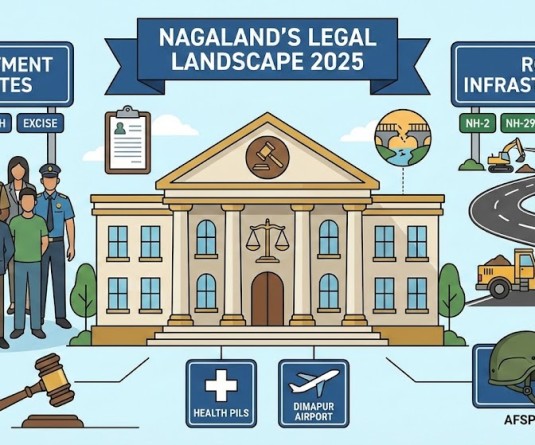Source: Household Consumption Expenditure Survey (HCES) 2022-23 & 2023-24, MoSPI and ‘Household Consumption of Various Goods & Services in Nagaland’ National Sample Survey 68th Round (July 2011 - June 2012), Directorate of Economics & Statistics, Nagaland.

Moa Jamir
Dimapur | January 30
Reflecting either strong culinary preferences or inflationary pressure, or both, protein-rich foods—specifically eggs, fish, and meat—dominate household budgets in Nagaland, according to the complete Household Consumption Expenditure Survey (HCES) data for 2023-24, released on January 30.
While earlier HCES Factsheet data from December 2024 by the Union Ministry of Statistics and Programme Implementation (MoSPI) indicated a rise of around 17% in average monthly expenditure in rural areas and 12% in urban households, the latest release presents the full dataset.
The Monthly Per Capita Consumption Expenditure (MPCE) in rural Nagaland was Rs 5,155 in 2023-24, an increase of Rs 762 from Rs 4,393 in 2022-23. In urban areas, MPCE rose from Rs 7,159 in 2022-23 to Rs 8,022 in 2023-24.
Main Drivers
The most notable surge in spending was on egg, fish, and meat over the past two years. In rural areas, the monthly per capita consumption expenditure (MPCE) on these items increased from Rs 652.53 in 2022-23 to Rs 707.08 in 2023-24, a rise of 8.36%.
Urban areas saw a much sharper increase, with MPCE jumping from Rs 868.56 to Rs 1,283.13, a substantial rise of 47.73%.
This trend aligns with the findings of the National Sample Survey (NSS) 68th Round from 2011-12, which highlighted the enduring significance of these food items in the state's consumption patterns.
As per the NSS data, egg, fish, and meat already constituted a significant portion of household spending, with MPCE on these items standing at Rs 307.12 in rural areas and Rs 299.73 in urban areas in 2011-12, highest among the food items.
Beyond Protein: Other Spending Trends
While egg, fish, and meat remain dominant, the HCES data also reveals other noteworthy spending patterns in Nagaland.
Spending on cereals has seen a moderate increase in both rural and urban areas over the past two years, with rural areas experiencing a 12.71% increase and urban areas a 15.25% increase.
This may indicate greater reliance on staple foods amidst rising prices. Rice remained the main staple cereal, constituting the bulk of consumption. In rural areas, out of an average monthly cereal consumption of 9.202 kilograms per person, 8.951 kg was rice.
Similarly, in urban areas, out of 9.397 kg of total cereal consumption, 9.245 kg was rice.
Nationally, of the 8.022 kg average monthly consumption of cereal products, 4.193 kg was rice and 3.622 kg was wheat.
Changing pattern
As previously reported, spending on beverages and processed food saw a substantial increase, reflecting changing lifestyles and greater accessibility to such products.
On those items, rural areas experienced a rise from Rs 425.11 in 2022-23 to Rs 500.28 in 2023-24, an increase of over 17.92%. Urban areas saw a 14% increase, with expenditure rising from Rs 744.42 to Rs 848.69.
Interestingly, in 2011-12, the second-highest MPCE was for ‘Clothing & Bedding’ in both rural and urban areas, at Rs 212.70 and Rs 254.12, respectively. However, a decade later, expenditure patterns revealed a significant shift.
In 2023-24, the second-highest MPCE, which includes both food and non-food items, was Rs 500.28 in rural areas and Rs 848.69 in urban areas. Spending on ‘Clothing & Bedding’ stood at Rs 421.74 in rural areas and Rs 610.29 in urban areas, respectively.
Spending on vegetables also increased, though not as sharply as on protein sources. Rural areas saw an 18.39% increase, while urban areas saw a 5.28% increase.
Interestingly, while fuel and light expenses increased slightly in rural areas (from Rs 268.95 to Rs 284.12), they decreased in urban areas (from Rs 382.78 to Rs 365.91), possibly due to lower consumption.
Expenditure on durable goods rose by over 19% in rural areas and 7% in urban areas during the same period. Similarly, conveyance expenses increased by around 12-14% in both sectors, though in absolute terms, they were lower in rural areas (Rs 311.12) compared to urban areas (Rs 549.36).
House rental expenses, though low, surged by over 16% in rural areas, rising from Rs 26.97 in 2022-23 to Rs 31.52 in 2023-24. In contrast, urban areas saw a 20% decrease, with spending dropping from Rs 410.73 to Rs 328.64.
Both rural and urban areas saw slight dips in education spending. Rural areas spent Rs 141.09 in 2023-24, down from Rs 142.23 in the previous year, while urban areas experienced a more significant decrease, from Rs 336.21 to Rs 273.21, a drop of around 18%.
Rural households’ monthly spending on pan, tobacco, and intoxicants increased from Rs 172.89 in 2022-23 to Rs 272.57 in 2023-24, while in urban areas, it rose from Rs 249.72 to Rs 326.08.
Meanwhile, the absolute gap between rural and urban MPCE increased from Rs 2,766 in 2022-23 to Rs 2,867 in 2023-24 (an increase of Rs 101). However, the gap narrowed in percentage terms, dropping from around 62.97% to 55.62%.
This suggests that while both rural and urban areas have experienced improvements, urban areas still have significantly higher per capita consumption.
In comparison, the average MPCE in rural and urban India in 2023-24 was Rs 4,122 and Rs 6,996, respectively. Nationally, the urban-rural gap in MPCE has decreased to 71% in 2023-24 from 84% in 2011-12, further confirming sustained consumption growth in rural areas, according to the report.
Nationally, key contributors to non-food expenditure in 2023-24 include conveyance, clothing, bedding and footwear, miscellaneous goods and entertainment, and durable goods.
The HCES gathers information on household consumption of goods and services, helping to understand patterns of expenditure, standard of living, and overall well-being. The survey typically spans from August of the current year to July of the following year, covering both food and non-food items as well as services.






